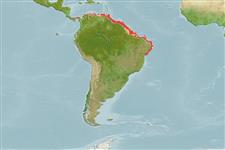Classification / Names
Common names from other countries
Main reference
Size / Weight / Age
Max length : 40.0 cm TL male/unsexed; (Ref. 5217); common length : 25.0 cm TL male/unsexed; (Ref. 5217); max. published weight: 1.2 kg (Ref. 5217)
Environment
Marine; reef-associated; depth range 0 - 70 m (Ref. 13608)
Climate / Range
Tropical, preferred ?; 12°N - 13°S, 82°W - 34°W
Distribution
Short description
Dorsal
spines
(total): 3;
Dorsal
soft rays
(total): 29;
Anal
spines: 0;
Anal
soft rays: 23 - 25;
Vertebrae: 36 - 38. Head depressed, trunk compressed; molariform teeth on both jaws; no venomous gland on any spine; body brownish dorsally with black diffuse mottlings, pale ventrally; lateral line pores distinct with white spots; fin membranes black distally (Ref. 13608).
IUCN Red List Status (Ref. 115185)
Threat to humans
Harmless
Human uses
Fisheries: minor commercial
More information
ReferencesAquacultureAquaculture profileStrainsGeneticsAllele frequenciesHeritabilityDiseasesProcessingMass conversion
Tools
Special reports
Download XML
Internet sources
Estimates of some properties based on models
Phylogenetic diversity index
PD50 = 0.7500 many relatives (e.g. carps) 0.5 - 2.0 few relatives (e.g. lungfishes)
Trophic Level
3.8 ±0.0 se; Based on diet studies.
Resilience
Low, minimum population doubling time 4.5 - 14 years (Preliminary K or Fecundity.)
Vulnerability
Moderate to high vulnerability (48 of 100)
Price category
